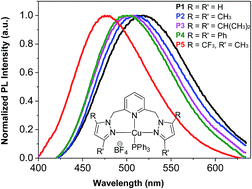Phosphorescent Cu(i) complexes based on bis(pyrazol-1-yl-methyl)-pyridine derivatives for organic light-emitting diodes†
Abstract
Mononuclear Cu(I) complexes based on bis(pyrazol-1-yl-methyl)-pyridine derivatives and ancillary triphenylphosphine have been prepared and characterized by 1H NMR, mass spectroscopy and single-crystal X-ray analysis. The thermogravimetric analysis shows that the complexes exhibit high thermal stability. The electronic absorption spectra display two features in the regions of 230–260 and 290–350 nm attributable to mixed ligand-to-ligand (LLCT) and metal-to-ligand-charge-transfer (MLCT) excited states, which is supported by the results of density functional theory (DFT) and time-dependent DFT (TDDFT) calculations on these Cu(I) complexes. These complexes are strongly emissive in the solid state at ambient temperature. Intense blue or green emission in the poly(methyl methacrylate) film is observed in the region of 475–518 nm for these complexes with the emission lifetimes in the microsecond time scale (12–20 μs), indicating that the emission may be phosphorescence emission. Increasing the steric hindrance of the substituents on the pyrazole unit results in a blue-shift of the emission bands and enhanced emission quantum efficiency in PMMA films. The two most emissive complexes have been used for the fabrication of phosphorescent organic light-emitting diodes (POLEDs).

- This article is part of the themed collection: 2015 Journal of Materials Chemistry C Hot Papers

 Please wait while we load your content...
Please wait while we load your content...